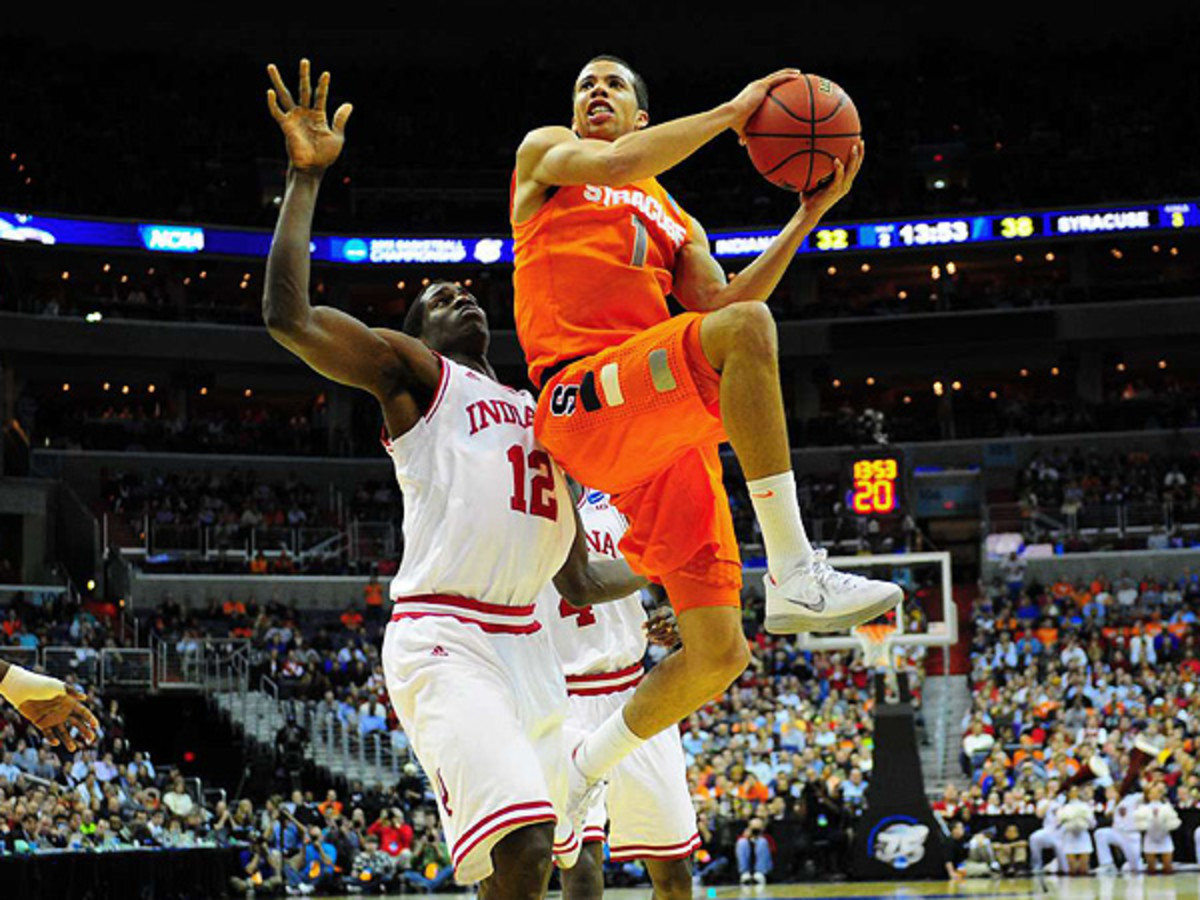Final Four Breakdown: Syracuse

Looking for Syracuse's X-factor? Might want to take a gander at Michael Carter-Williams. (Al Tielemans/SI)

Jim Boeheim is making his fourth Final Four appearance and is looking for his second national title a decade after then-freshman Carmelo Anthony helped lead the Orange past Kansas for the crown. If you (somehow) have not seen a lot of the Orange this season, here's a quick primer to catch you up and set the scene for this weekend:
How They Got Here
Syracuse was the 4-seed in the East regional. The Orange shredded Montana in the Round of 64 and then slipped past California to advance to the Sweet 16. There, they completely shut down 1-seed Indiana and then Big East foe Marquette, allowing a total of 89 points in the two wins. For the four games in the NCAA tournament, Syracuse has allowed an absurdly low 0.72 points per possession. There have been other developments that have helped, but the 2-3 zone has been devastating.
Strengths
A ton of attention will be placed this week on the Orange zone, and rightly so. They are playing defense at an extraordinarily high level at the moment, limiting NCAA tournament opponents to just 37 percent on two-point field goal attempts and 15 percent from the arc. Three of their four foes had absolutely no chance against it.
Jim Boeheim has said that his zone cannot take away all shots from an opponent, but the Orange are good at conceding the shots they most want to concede. This season, opponents have taken more than 40 percent of their field goal attempts from beyond the arc and have only made 28.2 percent of them.
Syracuse has been playing really good defense for the better part of four seasons now, so on the surface, this shouldn’t be a total surprise, but the Orange D was inconsistent down the stretch of the season. In the Big East tournament alone, three of the four opponents scored at least 1.07 points per possession. So what is fueling this uptick? Matchups have broken pretty well for them from the standpoint that their length has really caused opponents trouble. It also helps when teams are outside the conference and don’t see it as much. Plus not losing centers to injury or suspension has been a plus.
The Orange also get after it on the offensive glass and sport a strong turnover margin in their favor, meaning they create a number of “free” possessions for themselves each game. With James Southerland back in the fold, they also have a primary shooter who can hurt you from the perimeter. When he gets going, it helps everything else in the sometimes-suspect Orange attack.
[si_cvp_video id="video_9B827272-AFD1-C8AB-36A2-C6BC59F79397"]
Weaknesses
This is not a good offensive team by Syracuse standards. Outside of Southerland, the Orange’s three other primary perimeter shooters are all under 30 percent from the arc for the season. Their offense in their past three NCAA wins has been average or worse. The games have been mostly comfortable wins because the defense has been so dominating.
Like most Syracuse teams (because of the zone), they can be hurt on the offensive glass, but this Orange team is much closer to normal Cuse standards, unlike last year’s that was historically bad in that area. Syracuse also leads the nation in blocked shot percentage, so you may get putbacks, but they may also be put back into your face.
How They Match Up
This is the huge question going into Saturday’s second semifinal: How will the Orange zone be able to handle Michigan’s shooters? Over the weekend, SI colleague Tim Layden tweeted that Jim Boeheim privately didn’t want to play Michigan because of the diversity of their offensive attack and the overall quality of their skill players. They should have options to put at the high post to help exploit the zone. Plus, Mitch McGary could be an enormous problem for Cuse on the offensive glass.
That said, Boeheim has owned John Beilein in their head-to-head encounters. Beilein’s never had this much firepower to take into a game with Syracuse, but rest assured that Boeheim will know how to cope with it.
X-Factor
The easy answer is Southerland, because if he’s not shooting well, the Orange often struggle to score, but the best answer may be Michael Carter-Williams. He has a significant height advantage over both Michigan point guards and the Wolverines’ defense (as displayed by Kansas) can be susceptible to the drive. If he’s aggressive and doesn’t settle, he can set the tone for Cuse’s attack on the offensive end.
Prognosis
The game with Michigan is considered a coin flip, and the Orange, thanks to their familiarity with Louisville, may have a slightly better chance in a hypothetical final than Michigan. That means the Orange may have, modestly, the second best chance to win the national title this weekend, but their (and Michigan’s) chances are well lower than Louisville, which has the team playing the best and the much easier (relatively speaking) semifinal draw.
